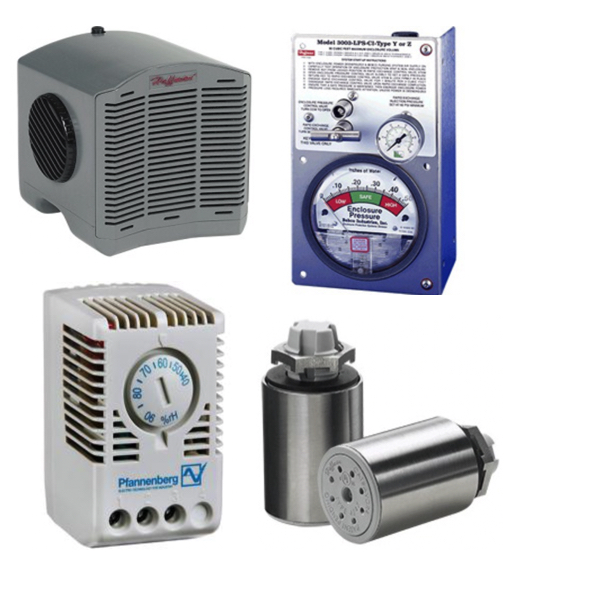Enclosure Pressure, Humidity & Condensation

Enclosure pressure, humidity, and condensation control products are critical for protecting electrical and electronic components in industrial environments. RSP Supply offers a full line of enclosure pressurization, purge, heating, and environmental control solutions designed to maintain safe internal conditions and preserve equipment reliability. These systems are commonly used in both indoor and outdoor enclosures where moisture, dust, corrosive gases, or explosive atmospheres may be present.
Maintaining positive internal pressure within an enclosure helps prevent the ingress of moisture, airborne contaminants, and flammable gases. By ensuring the internal pressure remains slightly higher than the surrounding environment, pressurization systems reduce the likelihood of condensation forming on sensitive electrical components. Condensation can cause corrosion, insulation breakdown, and electrical short circuits, making humidity management a key factor in long-term enclosure performance.
To further control condensation, enclosure heaters, air conditioners, ventilation systems, and purge units are often used in combination. Heaters regulate internal temperature to reduce relative humidity, while purge and pressurization systems continuously replace internal air with clean, dry air or inert gas. Many of these solutions are designed to meet ATEX, IEC, and other international safety standards, making them suitable for hazardous and high-humidity applications.
More Information about Enclosure Pressure, Humidity & Condensation Protection
In environments where the temperature and humidity fluctuate, it's essential to continuously monitor the air inside the enclosure. Devices that automatically trigger the purging process or control the flow of protective gas can be installed. This ensures that the air within the enclosure remains dry and at a constant flow, effectively preventing condensation. The concept of purging and pressurization in enclosures is typically regulated by standards such as the ATEX Directive or IEC standards, ensuring safety in hazardous environments. These standards dictate the level of pressurization required and the types of gases or air that can be used for maintaining a safe environment within the enclosure. Another aspect of managing humidity and condensation is ensuring proper ventilation while maintaining the required pressure and moisture levels. This could involve the use of ventilation systems that allow air to circulate within the enclosure while keeping moisture and hazardous gases out.
FAQs
Q: Why is positive pressure important in an electrical enclosure?
Positive pressure prevents outside air, moisture, dust, and hazardous gases from entering the enclosure. This helps protect internal components from corrosion, condensation, and ignition risks.
Q: How does humidity cause condensation inside an enclosure?
Condensation occurs when warm, moist air contacts cooler internal surfaces. As the air cools, it releases moisture, which can form water droplets on electrical components and lead to corrosion or electrical failure.
Q: What methods are used to prevent condensation in enclosures?
Common methods include enclosure heaters, air conditioners, purge systems, ventilation devices, and corrosion inhibitors. These solutions work together to control temperature and humidity levels inside the enclosure.
Q: How does air temperature affect enclosure pressure?
As air temperature increases, the air inside the enclosure expands, raising internal pressure. When temperature decreases, the air contracts, which can reduce pressure if additional air is not supplied.
Q: What standards regulate enclosure pressurization and purge systems?
Enclosure pressurization and purge systems are commonly governed by standards such as ATEX and IEC, which specify pressure levels, airflow requirements, and acceptable gases for use in hazardous locations.
Why Buy Enclosure Pressure, Humidity & Condensation Protection from RSP Supply
RSP Supply provides a comprehensive selection of enclosure pressure, humidity, and condensation control solutions from trusted manufacturers such as Hoffman. Our product offering supports compliance with industry safety standards while helping protect critical electrical equipment from moisture, corrosion, and environmental hazards. Customers rely on RSP Supply for dependable product availability, technical expertise, and solutions designed for demanding industrial applications.

